[English] 日本語
 Yorodumi
Yorodumi- PDB-4crp: Solution structure of a TrkAIg2 domain construct for use in drug ... -
+ Open data
Open data
- Basic information
Basic information
| Entry | Database: PDB / ID: 4crp | ||||||
|---|---|---|---|---|---|---|---|
| Title | Solution structure of a TrkAIg2 domain construct for use in drug discovery | ||||||
 Components Components | HIGH AFFINITY NERVE GROWTH FACTOR RECEPTOR | ||||||
 Keywords Keywords | TRANSFERASE / TRKAIG2 / NMR CONSTRUCT / PAIN / ALZHEIMERS | ||||||
| Function / homology |  Function and homology information Function and homology informationneurotrophin p75 receptor binding / behavioral response to formalin induced pain / olfactory nerve development / TRKA activation by NGF / PLC-gamma1 signalling / Signalling to STAT3 / programmed cell death involved in cell development / response to hydrostatic pressure / neurotrophin receptor activity / mechanoreceptor differentiation ...neurotrophin p75 receptor binding / behavioral response to formalin induced pain / olfactory nerve development / TRKA activation by NGF / PLC-gamma1 signalling / Signalling to STAT3 / programmed cell death involved in cell development / response to hydrostatic pressure / neurotrophin receptor activity / mechanoreceptor differentiation / nerve growth factor receptor activity / neurotrophin binding / GPI-linked ephrin receptor activity / nerve growth factor signaling pathway / axonogenesis involved in innervation / nerve growth factor binding / Sertoli cell development / Retrograde neurotrophin signalling / sympathetic nervous system development / NGF-independant TRKA activation / Signalling to p38 via RIT and RIN / ARMS-mediated activation / positive regulation of programmed cell death / positive regulation of Ras protein signal transduction / positive regulation of synapse assembly / PI3K/AKT activation / peptidyl-tyrosine autophosphorylation / Frs2-mediated activation / neurotrophin TRK receptor signaling pathway / detection of temperature stimulus involved in sensory perception of pain / positive regulation of GTPase activity / response to electrical stimulus / Signalling to RAS / detection of mechanical stimulus involved in sensory perception of pain / neuron development / positive regulation of synaptic transmission, glutamatergic / response to axon injury / transmembrane receptor protein tyrosine kinase activity / axon guidance / cell surface receptor protein tyrosine kinase signaling pathway / peptidyl-tyrosine phosphorylation / B cell differentiation / response to nutrient levels / positive regulation of NF-kappaB transcription factor activity / positive regulation of neuron projection development / circadian rhythm / receptor protein-tyrosine kinase / cellular response to nerve growth factor stimulus / cellular response to nicotine / kinase binding / recycling endosome membrane / positive regulation of angiogenesis / neuron projection development / late endosome membrane / late endosome / protein autophosphorylation / protein tyrosine kinase activity / neuron apoptotic process / early endosome membrane / spermatogenesis / negative regulation of neuron apoptotic process / learning or memory / early endosome / positive regulation of ERK1 and ERK2 cascade / protein phosphorylation / positive regulation of phosphatidylinositol 3-kinase/protein kinase B signal transduction / receptor complex / endosome membrane / response to xenobiotic stimulus / negative regulation of cell population proliferation / axon / neuronal cell body / dendrite / negative regulation of apoptotic process / cell surface / protein homodimerization activity / protein-containing complex / mitochondrion / ATP binding / identical protein binding / plasma membrane Similarity search - Function | ||||||
| Biological species |  HOMO SAPIENS (human) HOMO SAPIENS (human) | ||||||
| Method | SOLUTION NMR / ARIA 2.3 | ||||||
 Authors Authors | Shoemark, D.K. / Fahey, M. / Williams, C. / Sessions, R.B. / Crump, M.P. / Allen-Birt, S.J. | ||||||
 Citation Citation |  Journal: J.Med.Chem. / Year: 2015 Journal: J.Med.Chem. / Year: 2015Title: Design and Nuclear Magnetic Resonance (NMR) Structure Determination of the Second Extracellular Immunoglobulin Tyrosine Kinase a (Trkaig2) Domain Construct for Binding Site Elucidation in Drug Discovery Authors: Allen, S.J. / Watson, J.J. / Shoemark, D.K. / Barua, N.U. / Patel, N.K. | ||||||
| History |
|
- Structure visualization
Structure visualization
| Structure viewer | Molecule:  Molmil Molmil Jmol/JSmol Jmol/JSmol |
|---|
- Downloads & links
Downloads & links
- Download
Download
| PDBx/mmCIF format |  4crp.cif.gz 4crp.cif.gz | 847.3 KB | Display |  PDBx/mmCIF format PDBx/mmCIF format |
|---|---|---|---|---|
| PDB format |  pdb4crp.ent.gz pdb4crp.ent.gz | 723.5 KB | Display |  PDB format PDB format |
| PDBx/mmJSON format |  4crp.json.gz 4crp.json.gz | Tree view |  PDBx/mmJSON format PDBx/mmJSON format | |
| Others |  Other downloads Other downloads |
-Validation report
| Summary document |  4crp_validation.pdf.gz 4crp_validation.pdf.gz | 472.3 KB | Display |  wwPDB validaton report wwPDB validaton report |
|---|---|---|---|---|
| Full document |  4crp_full_validation.pdf.gz 4crp_full_validation.pdf.gz | 817.4 KB | Display | |
| Data in XML |  4crp_validation.xml.gz 4crp_validation.xml.gz | 93.7 KB | Display | |
| Data in CIF |  4crp_validation.cif.gz 4crp_validation.cif.gz | 93.1 KB | Display | |
| Arichive directory |  https://data.pdbj.org/pub/pdb/validation_reports/cr/4crp https://data.pdbj.org/pub/pdb/validation_reports/cr/4crp ftp://data.pdbj.org/pub/pdb/validation_reports/cr/4crp ftp://data.pdbj.org/pub/pdb/validation_reports/cr/4crp | HTTPS FTP |
-Related structure data
| Similar structure data | |
|---|---|
| Other databases |
- Links
Links
- Assembly
Assembly
| Deposited unit | 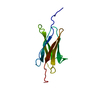
| |||||||||
|---|---|---|---|---|---|---|---|---|---|---|
| 1 |
| |||||||||
| NMR ensembles |
|
- Components
Components
| #1: Protein | Mass: 11792.068 Da / Num. of mol.: 1 Fragment: EXTRACELLULAR NGF BINDING DOMAIN, RESIDUES 270-383 Mutation: YES Source method: isolated from a genetically manipulated source Details: P285C, F367C INTRODUCED TO ADD A DISULPHIDE BOND TO IMPROVE PROTEIN STABILITY Source: (gene. exp.)  HOMO SAPIENS (human) / Plasmid: PET24A / Production host: HOMO SAPIENS (human) / Plasmid: PET24A / Production host:  References: UniProt: P04629, receptor protein-tyrosine kinase |
|---|---|
| Has protein modification | Y |
| Sequence details | ENGINEERED |
-Experimental details
-Experiment
| Experiment | Method: SOLUTION NMR | ||||||||||||||||||||||||||||||||
|---|---|---|---|---|---|---|---|---|---|---|---|---|---|---|---|---|---|---|---|---|---|---|---|---|---|---|---|---|---|---|---|---|---|
| NMR experiment |
| ||||||||||||||||||||||||||||||||
| NMR details | Text: THE STRUCTURE WAS DETERMINED USING TRIPLE-RESONANCE NMR SPECTROSCOPY ON 15N AND 13C, 15N-LABELED SAMPLES |
- Sample preparation
Sample preparation
| Details | Contents: 90% H2O, 10% D2O |
|---|---|
| Sample conditions | Ionic strength: 10 mM / pH: 6.9 / Pressure: 1.0 atm / Temperature: 293.0 K |
-NMR measurement
| NMR spectrometer | Type: Varian VNMRS / Manufacturer: Varian / Model: VNMRS / Field strength: 600 MHz |
|---|
- Processing
Processing
| NMR software |
| ||||||||||||
|---|---|---|---|---|---|---|---|---|---|---|---|---|---|
| Refinement | Method: ARIA 2.3 / Software ordinal: 1 / Details: WATER REFINED USING THE RECOORD PROTOCOL | ||||||||||||
| NMR ensemble | Conformer selection criteria: LOWEST ENERGY, LEAST VIOLATION Conformers calculated total number: 250 / Conformers submitted total number: 25 |
 Movie
Movie Controller
Controller



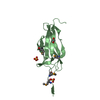

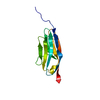
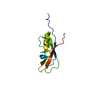

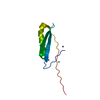
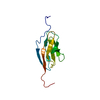
 PDBj
PDBj









 HNCA
HNCA